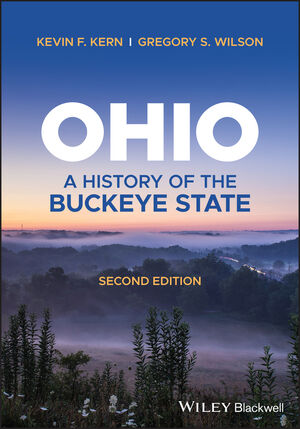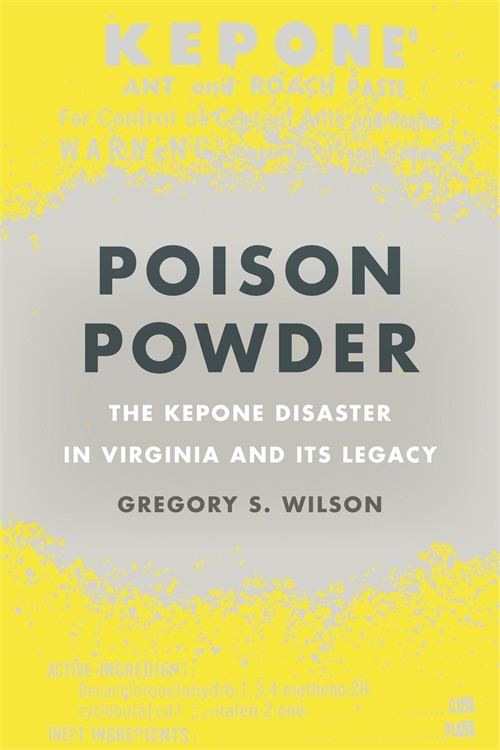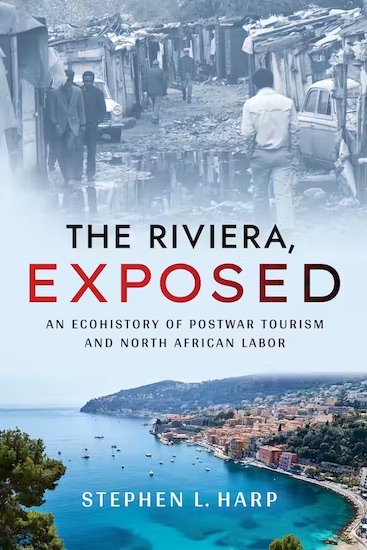
Books by History Faculty
History department faculty members spend a great deal of time outside the classroom working on research projects in their specific fields of interest. This research directly benefits students and often results in the publication of scholarly articles and books.
Kevin F. Kern and Gregory S. Wilson
Ohio: A History of the Buckeye State, 2nd Edition
Wiley-Blackwell, 2023
Now in its second edition, Ohio: A History of the Buckeye State surveys the long and rich history of Ohio from its earliest geological periods to the present day. Designed for undergraduate students and general readers alike, this accessible volume describes the pivotal events in Ohio’s history while discussing the major social, economic, and political trends that have shaped the state over time. Concise chapters cover Ohio prehistory and the First Ohioans, European contact, the formation of the Northwest Territory, early statehood and national politics, the Civil War, Reconstruction, the two World Wars, the 1950s and 1960s, and more.
Incorporating the latest scholarship from history, archaeology, and political science, the second edition moves the story of Ohio into the second decade of the twenty-first century. Revised chapters contain new data and updated coverage of early Ohio society, major economic developments, early statehood, Ohio and national politics, and Ohio from the 1970s through 2020.
Written by two authors with decades of combined academic experience in teaching Ohio history, Ohio: A History of the Buckeye State, Second Edition remains an essential resource for college-level students enrolled in courses on Ohio History, professionals working in historical societies, museums, and other institutions that focus on the state’s history, and general readers looking for a highly readable study of Ohio’s past.
Gregory S. Wilson
Poison Powder: The Kepone Disaster in Virginia and Its Legacy
University of Georgia Press, 2023
In 1975 workers at Life Science Products, a small makeshift pesticide factory in Hopewell, Virginia, became ill after exposure to Kepone, the brand name for the pesticide chlordecone. They made the poison under contract for a much larger Hopewell company, Allied Chemical. Life Science workers had been breathing in the dust for more than a year. Ingestion of the chemical made their bodies seize and shake. News of ill workers eventually led to the discovery of widespread environmental contamination of the nearby James River and the landscape of the small, working-class city. Not only had Life Science dumped the chemical, but so had Allied when the company manufactured it in the 1960s and early 1970s. The resulting toxic impact was not only on the city of Hopewell but also on the faraway fields where Kepone was used as an insecticide.
Aspects of this environmental tragedy are all too common: corporate avarice, ignorance, and regulatory failure combined with race and geography to determine toxicity and shape the response. But the Kepone story also contains some surprising medical, legal, and political moments amid the disaster. With Poison Powder, Gregory S. Wilson explores the conditions that put the Kepone factory and the workers there in the first place and the effects of the poison on the people and natural world long after 1975. Although the manufacture and use of Kepone is now banned by the Environmental Protection Agency, organochlorines have long half-lives, and these toxic compounds and their residues still remain in the environment.
Stephen L. Harp
The Riviera, Exposed: An Ecohistory of Postwar Tourism and North African Labor
Cornell University Press, 2022
A sweeping social and environmental history, The Riviera, Exposed illuminates the profound changes to the physical space that we know as the quintessential European tourist destination. Stephen L. Harp uncovers the behind-the-scenes impact of tourism following World War II, both on the environment and on the people living and working on the Riviera, particularly North African laborers, who not only did much of the literal rebuilding of the Riviera but also suffered in that process.
Outside of Paris, the Riviera has been the most visited region in France, depending almost exclusively on tourism as its economic lifeline. Until recently, we knew a great deal about the tourists but much less about the social and environmental impacts of their activities or about the life stories of the North African workers upon whom the Riviera's prosperity rests. The technologies embedded in roads, airports, hotels, water lines, sewers, beaches, and marinas all required human intervention—and travelers were encouraged to disregard this intervention. Harp's sharp analysis explores the impacts of massive construction and public works projects, revealing the invisible infrastructure of tourism, its environmental effects, and the immigrants who built the Riviera.
The Riviera, Exposed unearths a gritty history, one of human labor and ecological degradation that forms the true foundation of the glamorous Riviera of tourist mythology.
A. Martin Wainwright
Virtual History: How Videogames Portray the Past
Routledge, 2019
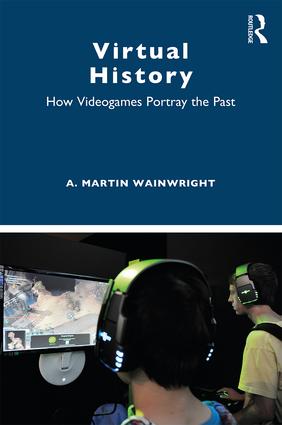 Virtual History examines many of the most popular historical video games released over the last decade and explores their portrayal of history.
Virtual History examines many of the most popular historical video games released over the last decade and explores their portrayal of history.
The book looks at the motives and perspectives of game designers and marketers, as well as the societal expectations addressed, through contingency and determinism, economics, the environment, culture, ethnicity, gender, and violence. Approaching videogames as a compelling art form that can simultaneously inform and mislead, the book considers the historical accuracy of videogames, while also exploring how they depict the underlying processes of history and highlighting their strengths as tools for understanding history. The first survey of the historical content and approach of popular videogames designed with students in mind, it argues that games can depict history and engage players with it in a useful way, encouraging the reader to consider the games they play from a different perspective.
Supported by examples and screenshots that contextualize the discussion, Virtual History is a useful resource for students of media and world history as well as those focusing on the portrayal of history through the medium of videogames.
Walter Hixson
Israel's Armor: The Israel Lobby and the First Generation of the Palestine Conflict
Cambridge University Press, 2019
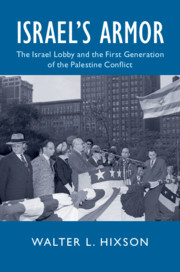 The United States and Israel have long had a 'special relationship'. The US became the first country in the world to recognize the state of Israel in 1948, and has been an important ally and benefactor ever since. A critical component of the special relationship is the pro-Israel lobby. Although the lobby has been a controversial topic in public affairs, it has been widely understudied. Israel's Armor fills a gap in the existing literature by examining the origins and early history of the Israel lobby, looking at its influence on American foreign policy, and weaving its activities into the diplomatic history of the first generation of the Palestine conflict. Covering the period roughly from World War II to the pivotal June War, 1967, Walter L. Hixson demonstrates that the Israel lobby from the outset played a crucial role in mobilizing US support for the Zionist state.
The United States and Israel have long had a 'special relationship'. The US became the first country in the world to recognize the state of Israel in 1948, and has been an important ally and benefactor ever since. A critical component of the special relationship is the pro-Israel lobby. Although the lobby has been a controversial topic in public affairs, it has been widely understudied. Israel's Armor fills a gap in the existing literature by examining the origins and early history of the Israel lobby, looking at its influence on American foreign policy, and weaving its activities into the diplomatic history of the first generation of the Palestine conflict. Covering the period roughly from World War II to the pivotal June War, 1967, Walter L. Hixson demonstrates that the Israel lobby from the outset played a crucial role in mobilizing US support for the Zionist state.
Gina M. Martino
Women at War in the Borderlands of the Early American Northeast
University of North Carolina Press, 2018
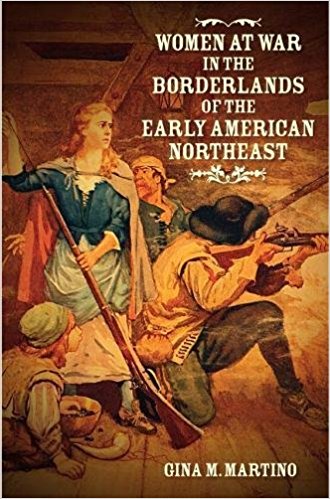 Across the borderlands of the early American northeast, New England, New France, and Native nations deployed women with surprising frequency to the front lines of wars that determined control of North America. Far from serving as passive helpmates in a private, domestic sphere, women assumed wartime roles as essential public actors, wielding muskets, hatchets, and makeshift weapons while fighting for their families, communities, and nations. Revealing the fundamental importance of martial womanhood in this era, Gina M. Martino places borderlands women in a broad context of empire, cultural exchange, violence, and nation building, demonstrating how women's war making was embedded in national and imperial strategies of expansion and resistance. As Martino shows, women's participation in warfare was not considered transgressive; rather it was integral to traditional gender ideologies of the period, supporting rather than subverting established systems of gender difference.
Across the borderlands of the early American northeast, New England, New France, and Native nations deployed women with surprising frequency to the front lines of wars that determined control of North America. Far from serving as passive helpmates in a private, domestic sphere, women assumed wartime roles as essential public actors, wielding muskets, hatchets, and makeshift weapons while fighting for their families, communities, and nations. Revealing the fundamental importance of martial womanhood in this era, Gina M. Martino places borderlands women in a broad context of empire, cultural exchange, violence, and nation building, demonstrating how women's war making was embedded in national and imperial strategies of expansion and resistance. As Martino shows, women's participation in warfare was not considered transgressive; rather it was integral to traditional gender ideologies of the period, supporting rather than subverting established systems of gender difference.
In returning these forgotten women to the history of the northeastern borderlands, this study challenges scholars to reconsider the flexibility of gender roles and reveals how women's participation in transatlantic systems of warfare shaped institutions, polities, and ideologies in the early modern period and the centuries that followed.
Greg Wilson Co-authored with Craig S. Simpson
Above the Shots: An Oral History of the Kent State Shootings
Kent State University Press, 2016
 A deadly confrontation at Kent State University between Vietnam War protesters and members of the Ohio National Guard occurred in the afternoon on May 4, 1970. What remained, along with the tragic injuries and lives lost, was a remarkable array of conflicting interpretations and theories about what happened—and why. Above the Shots sheds new light on this historic event through the recollections of more than 50 narrators, whose stories are unique and riveting.
A deadly confrontation at Kent State University between Vietnam War protesters and members of the Ohio National Guard occurred in the afternoon on May 4, 1970. What remained, along with the tragic injuries and lives lost, was a remarkable array of conflicting interpretations and theories about what happened—and why. Above the Shots sheds new light on this historic event through the recollections of more than 50 narrators, whose stories are unique and riveting.
From the precipitous cultural conflicts of the 1960s to the ever-raging battle over how to remember the Kent State incident, the authors examine how these accounts challenge and deepen our understanding of the shootings, the Vietnam Era, memory, and oral history. Spanning five decades, Above the Shots not only chronicles the immediate chain of events that led to the shootings but explores causes and consequences, prevailing conspiracies, and the search for catharsis. It is a narrative assemblage of voices that rise above the rhetoric—above the din—to show how a watershed moment in modern American history continues to speak to us.
Stephen L. Harp
A World History of Rubber: Empire, Industry, and the Everyday
Wiley-Blackwell, 2015
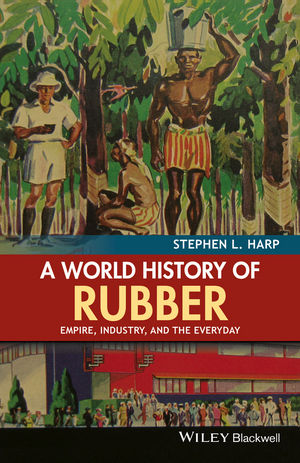 A World History of Rubber helps readers understand and form new insights into the social and cultural contexts of global production and consumption from the nineteenth century to the present. Stephen Harp uses rubber as a lens through which readers can view many key themes and events of the nineteenth and twentieth centuries, including imperialism, industrialization, racism, and inequality.
A World History of Rubber helps readers understand and form new insights into the social and cultural contexts of global production and consumption from the nineteenth century to the present. Stephen Harp uses rubber as a lens through which readers can view many key themes and events of the nineteenth and twentieth centuries, including imperialism, industrialization, racism, and inequality.
The book illuminates the complex journey of rubber from plantations in far-flung European colonies, to factories in Midwest America, to products in American homes and abroad. It is divided into five thematic sections: race, migration, and labor; gender on plantations and in factories; demand and everyday consumption; World Wars and nationalism; and resistance and independence. The story highlights the interrelatedness of our world long before the current era of globalization, as well as the global social inequalities that persist today. With an engaging and accessible narrative that will resonate with students of all levels as well as general readers, this account of a single commodity skillfully ties together the history of many people, places, and ideas the whole world over.
Walter Hixson
American Foreign Relations: A New Diplomatic History
Routledge, Taylor & Francis Group, 2015
 American Foreign Relations: A New Diplomatic History is a compelling narrative history of American foreign policy from the early settlement of North America to the present. In addition to economic and strategic motives, Walter L. Hixson integrates key cultural factors—including race, gender, and religion—into the story of American foreign policy. He demonstrates how these factors played a vital role in shaping the actions of the United States in world affairs. Beginning with the history of warfare and diplomacy between indigenous peoples and Europeans before the establishment of the United States, this book shows the formative influence of settler colonialism on the country’s later foreign policy and the growth of American empire.
American Foreign Relations: A New Diplomatic History is a compelling narrative history of American foreign policy from the early settlement of North America to the present. In addition to economic and strategic motives, Walter L. Hixson integrates key cultural factors—including race, gender, and religion—into the story of American foreign policy. He demonstrates how these factors played a vital role in shaping the actions of the United States in world affairs. Beginning with the history of warfare and diplomacy between indigenous peoples and Europeans before the establishment of the United States, this book shows the formative influence of settler colonialism on the country’s later foreign policy and the growth of American empire.
In one concise volume, American Foreign Relations covers the full sweep of American foreign policy from the colonial period to the present day. It is an essential introduction for anyone seeking to understand the history of America’s role in the world.
Lesley Gordon
A Broken Regiment: The 16th Connecticut's Civil War
Louisiana State University Press, 2014
A Broken Regiment recounts the tragic history of one of the Civil War’s most ill-fated Union military units. Organized in the late summer of 1862, the 16th Connecticut Volunteer Infantry was unprepared for battle a month later, when it entered the fight at Antietam. The results were catastrophic: nearly a quarter of the men were killed or wounded, and Connecticut’s 16th panicked and fled the field. In the years that followed, the regiment participated in minor skirmishes before surrendering en masse in North Carolina in 1864. Most of its members spent months in southern prison camps, including the notorious Andersonville stockade, where disease and starvation took the lives of over one hundred members of the unit.
The struggles of the 16th led survivors to reflect on the true nature of their military experience during and after the war, and questions of cowardice and courage, patriotism and purpose, were often foremost in their thoughts. Over time, competing stories emerged of who they were, why they endured what they did, and how they should be remembered. By the end of the century, their collective recollections reshaped this troubling and traumatic past, and the “unfortunate regiment” emerged as the "Brave Sixteenth,” their individual memories and accounts altered to fit the more heroic contours of the Union victory.
The product of over a decade of research, Lesley J. Gordon’s A Broken Regiment illuminates this unit’s complex history amid the interplay of various, and often competing, voices. The result is a fascinating and heartrending story of one regiment’s wartime and postwar struggles.
Constance Bouchard
Rewriting Saints and Ancestors: Memory and Forgetting in France, 500-1200
University of Pennsylvania Press, 2014
Thinkers in medieval France constantly reconceptualized what had come before, interpreting past events to give validity to the present and help control the future. The long-dead saints who presided over churches and the ancestors of established dynasties were an especially crucial part of creative memory, Constance Brittain Bouchard contends. In Rewriting Saints and Ancestors she examines how such ex post facto accounts are less an impediment to the writing of accurate history than a crucial tool for understanding the Middle Ages.
Working backward through time, Bouchard discusses twelfth-century scribes contemplating the ninth-century documents they copied into cartularies or reworked into narratives of disaster and triumph, ninth-century churchmen deliberately forging supposedly late antique documents as weapons against both kings and other churchmen, and sixth- and seventh-century Gallic writers coming to terms with an early Christianity that had neither the saints nor the monasteries that would become fundamental to religious practice. As they met with political change and social upheaval, each generation decided which events of the past were worth remembering and which were to be reinterpreted or quietly forgotten. By considering memory as an analytic tool, Bouchard not only reveals the ways early medieval writers constructed a useful past but also provides new insights into the nature of record keeping, the changing ways dynasties were conceptualized, the relationships of the Merovingian and Carolingian kings to the church, and the discovery (or invention) of Gaul's earliest martyrs
Stephen Harp
Au Naturel: Naturism, Nudism, and Tourism in Twentieth-Century France
Louisiana State University Press, 2014
In the decades after the Second World War, France became the foremost nudist site in Europe. Stephen L. Harp‘s new book, Au Naturel: Naturism, Nudism, and Tourism in Twentieth-Century France explains how this came to be. A study of nudist ideas, activity, and sites from the interwar years to the mid-1970s, the book is a fascinating history of the people and places that made nude tourism and leisure a major phenomenon in France.
Building on previous scholarship that has explored nudism in different national contexts, Au Naturel is a transnational history that illuminates the movement of bodies, beliefs, and practices across political borders, and the emergence of a postwar European community from a unique perspective. Drawing on a rich archive of materials from the local to the international, Harp reveals that nudism was both cultural and political in its meanings and effects in and beyond France. A history of the body and sexuality, Au Naturel is a story of shifting landscapes and values that will be of tremendous interest to readers across multiple fields.
Walter Hixson
Palgrave Macmillan, 2013
Over the course of three centuries, American settlers spread throughout North America and beyond, driving out indigenous populations to establish exclusive and permanent homelands of their own. In doing so, they helped to create the richest and most powerful nation in human history, even as they caused the death and displacement of millions of people. This groundbreaking historical synthesis demonstrates that the United States is and has always been fundamentally a settler colonial society - and, indeed, that its growth as a country represents the most sweeping, violent, and significant instance of the phenomenon in history. Linking episodes too often treated in isolation - including Indian removal, the Mexican and Civil Wars, and the settlement of Alaska and Hawaii - it upends many familiar categories of US history and presents a compelling yet disturbing framework through which to understand America's rise to global dominance.
Kevin Kern & Greg Wilson
Ohio - A History of the Buckeye State
Wiley-Blackwell, 2013
Professors Kevin Kern and Gregory Wilson have just published Ohio: A History of the Buckeye State. Hailed by Purdue University’s R. Douglas Hurt as “The best book on Ohio’s history in more than a generation,” the new volume builds on our department’s long-recognized prominence in the field of Ohio History that Professor Emeritus George Knepper established during his illustrious career. Drawing on the latest scholarship from history, archaeology, and political science, the interdisciplinary and thematic text explores the entire range of Ohio’s past from the earliest geological periods to the present day while weaving together major social, economic, and political trends over time.
The book has the distinction of being the first survey of Ohio history designed specifically for use in college-level courses, but Miami University’s Andrew Cayton believes it will have an even broader appeal: “Kevin Kern and Gregory Wilson’s readable, authoritative, and comprehensive book immediately becomes the standard point of departure for anyone interested in learning about Ohio’s rich and diverse past.”

